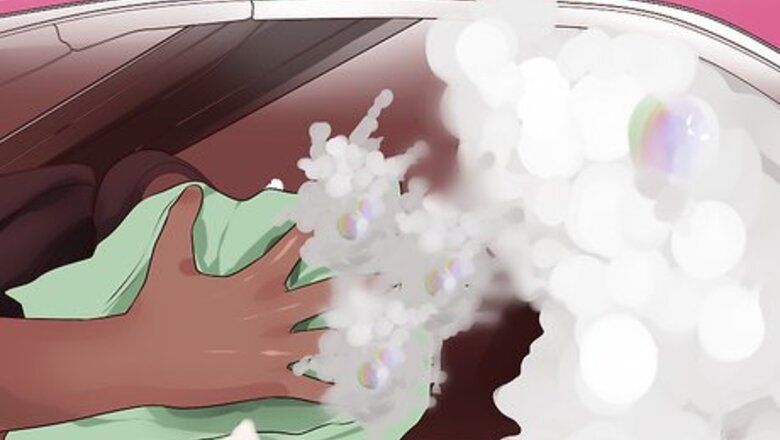
views
Keeping Your Car Clean and Maintained
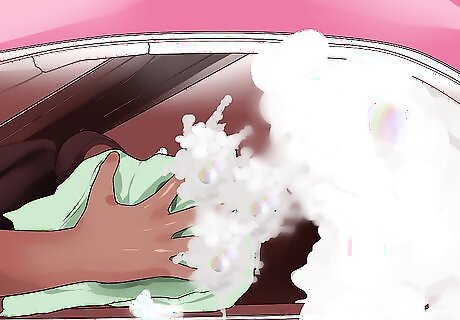
Keep your windows clean and clear. Being able to see properly is key to driving safely any time, especially when visibility is already reduced because of rain. To improve your visibility: Clean the inside and outside of the windows regularly to remove dirt, dust, mud, smoke, fingerprints, grime, and other materials. If your windows fog up, turn on the air conditioning or cold air in the car and aim the vents at the windows. Turn on the rear defroster, and open the windows if necessary to increase the airflow.

Maintain your lights. Take your car to a mechanic to have your headlights adjusted properly if you've never done this. This will ensure your headlights are pointing in the right direction, make it easier to see, and prevent you from blinding other drivers. Check regularly to make sure none of your lights have burnt out, and replace dead lights immediately. This includes headlights, brake lights, turn signals, tail lights, and running lights. Keep the light covers on your car clean so that dust and dirt don't reduce their efficacy.
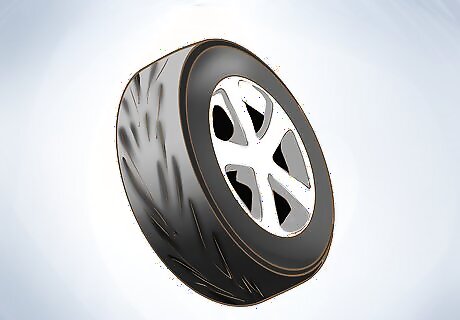
Maintain your tires. Tire tread is what allows your tires to adhere to the road, which is why it's so dangerous to drive with bald tires. Without the right traction, you can skid, slide, and hydroplane easily in wet conditions. New tires generally have about 10/32 of an inch of tread. Tires should be replaced when the tread gets to 4/32 of an inch. Tires with 2/32 of an inch or less of tread are unsafe and shouldn't be used.
Driving Appropriately for the Conditions
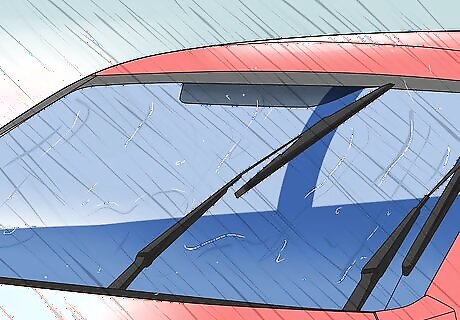
Turn on your windshield wipers. Along with keeping your windshield clean, you can also improve your visibility in wet conditions by ensuring that your wipers are up to the job, and by using the right washer fluid. Replace your wipers every year to prevent them from cracking, breaking, or not sealing properly when you need them most. Try a hydrophobic washer fluid that will cause water to bead up and drip off your windshield, rather than sticking to it and blocking your view.
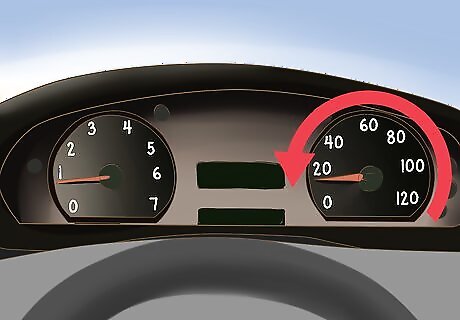
Slow down. During any inclement weather or unfavorable driving conditions, your first reaction should always be to adjust your speed accordingly. Wet roads reduce your traction, and slowing down reduces the chances of you skidding out, and will give you more time to react to emergencies. Wet roads can reduce your traction by about a third, so you should also reduce your speed by a third. Even small amounts of water can make the road more slippery, because the water mixes with oils on the road, and this creates a greasy layer. Driving too quickly on wet roads can lead to hydroplaning, which means that your tires lose contact with the road. When a car hydroplanes, you have very little control in terms of steering or braking.
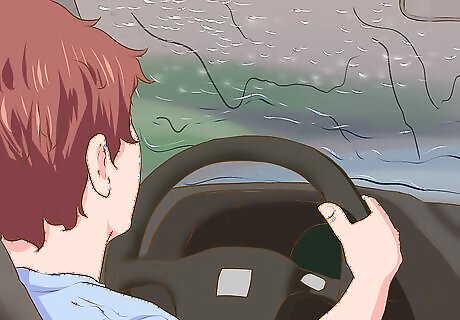
Stay focused. When you're behind the wheel, it's important to always pay attention to the road, other cars, and pedestrians. This is especially true in the rain, when you cannot see as well, and your ability to stop may be hindered by the slickness of the road. Stay focused by: Keeping your eyes on the road at all times Paying attention to what drivers and pedestrians are doing around you. Turning off the radio, and ignoring your cell phone and other electronic devices. Ceasing any conversations you were having with passengers. Not eating, reading, or putting on makeup while driving.
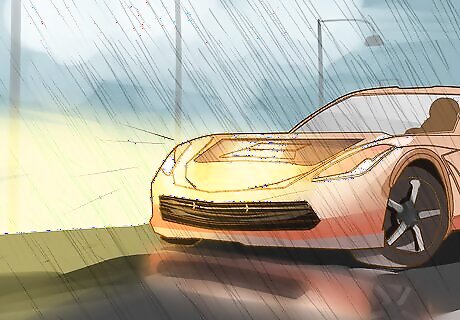
Turn your lights on. When it starts to rain, turn on your headlights immediately, regardless of whether it's day or night. In some states, it's actually illegal to drive without headlights when it's raining. There are two reasons why you should drive with your lights on in the rain: First of all, your headlights will make it easier for other drivers to see your car. Second, rain typically means cloudy skies, and turning your lights on will help you see the road better.
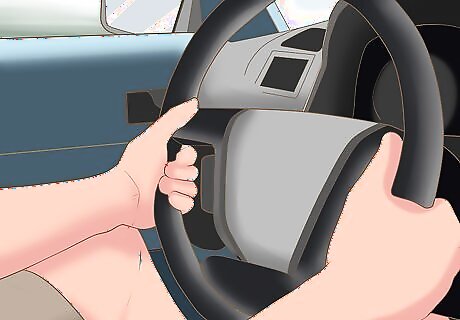
Drive with both hands on the wheel. You should always drive with your hands at 9 o'clock and 3 o'clock on the steering wheel, because this gives you maximum control if you have to turn, swerve, or react quickly. It's especially important to have both hands on the wheel when driving conditions are subpar. While traditional wisdom said to drive with your hands at 10 o'clock and 2 o'clock on the steering wheel, this increases the chances of injury from airbags in case of a collision.
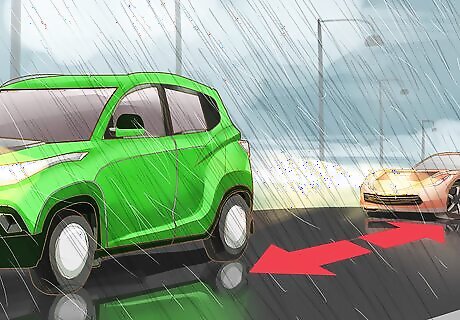
Stay five seconds behind the car in front of you. You should always leave a three- to four-second gap between your car and the car in front of you, and you should increase this to at least five seconds when it's raining. Not only does this give you more time to stop or adjust if necessary, but it also prevents reduced visibility caused by the spray from other cars. To determine how many seconds you are behind another car, make note of when that car passes a landmark (like a street sign) and then count how many seconds it takes before your car passes that same landmark. Leaving space includes leaving an opening where you can escape quickly if necessary. To do this, make sure you always leave at least one open space beside or in front of you that you can move into. EXPERT TIP Simon Miyerov Simon Miyerov Driving Instructor Simon Miyerov is the President and Driving Instructor for Drive Rite Academy, a driving academy based out of New York City. Simon has over 8 years of driving instruction experience. His mission is to ensure the safety of everyday drivers and continue to make New York a safer and efficient driving environment. Simon Miyerov Simon Miyerov Driving Instructor Our Expert Agrees: If you're driving in wet conditions, it's important to leave plenty of space between the cars around you. Drive with the flow of traffic and try not to get too close to any vehicles so you don't accidentally rear-end them if you have to stop suddenly.
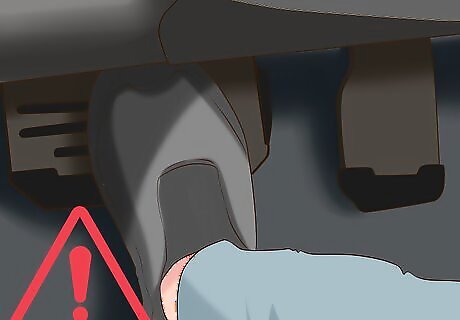
Avoid slamming on the brakes. Slamming on the brakes can cause you to slide forward, and you won't be able to control the car. Hitting the brakes too hard can also force water into your brakes, making them less effective. Instead of braking, you can also slow yourself down by easing off the accelerator, and downshifting if you have a manual transmission. Not being able to stop as quickly in the rain is another reason why it's so important to leave extra space between your car and the one in front of you.
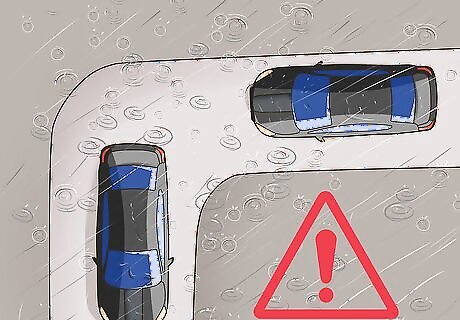
Take turns slowly. Turning too quickly on a wet road can cause your tires to hydroplane, and this means you won't be able to control the car, and could skid out. Whenever you have a turn coming up, signal early and start slowing down sooner than you would in good conditions. Just like with driving, you should reduce the speed of your turns by about a third when it's raining.
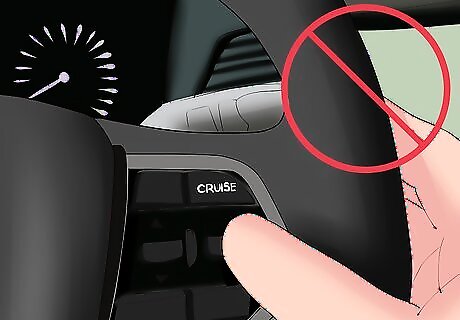
Don't use cruise control. Cruise control is another factor that can lead to hydroplaning. The weight of the car shifts slightly when you ease on or off the accelerator, and this helps the tires maintain traction with the road. But with cruise control, because the speed of the car is constant, there is no weight shift, and the car can lose traction.
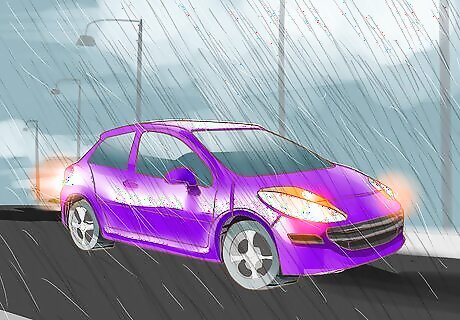
Pull over if necessary. Never be afraid to pull over to the side of the road if you don't feel comfortable driving. If you can't see the sides of the road, the cars in front of you, or your surroundings at a safe distance, pull over. Other things that can reduce your visibility include the glare from other car lights and lightning. You may also need to pull over if there's too much water on the road, the road is too slick, or you simply don't feel safe. To pull over safely, turn on your signal, check your mirror and blind spots, pull over as far as possible to the side of the road, and turn on your four-way lights.
Reacting to Emergencies
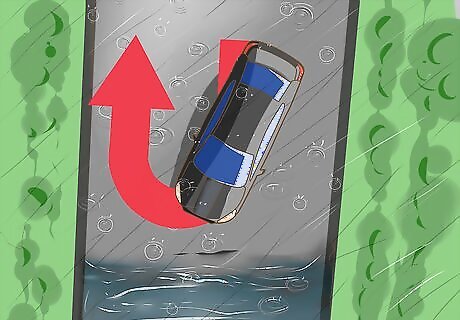
Turn around if you encounter deep or moving water. Driving through deep or moving water can be hazardous for a number of reasons, including that you could get stuck, stall out, damage the car or the electrical components, or be swept away. Moving water is too deep if you cannot see the ground. Don't proceed through deep water if it comes higher than the bottom of your door. If you encounter these types of road flooding, turn around and find another route. In a case where the only route is blocked, pull over and wait out the flooding.
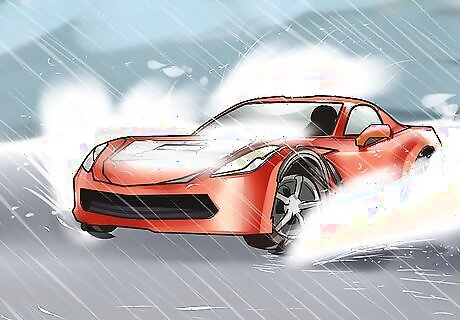
Be prepared to react if you hydroplane. Hydroplaning can occur at speeds as low as 35 miles (56 km) per hour, and when it happens your car may not react when you turn the steering wheel, and your back end may feel loose. In the event that your car does hydroplane: Stay calm Avoid turning the steering wheel Ease your foot off the accelerator Apply slow and gentle pressure to the brakes
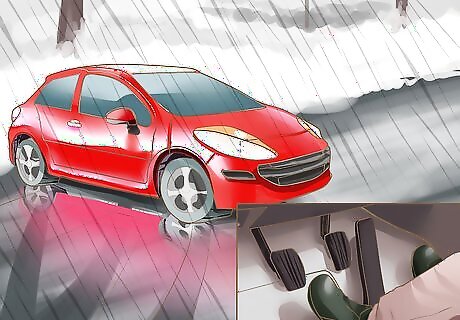
Know what to do if you start to skid. Skidding on a wet road can be particularly frightening, but like any emergency situation, the key is remaining calm. Then, look where you want to go, ease your foot off the accelerator, and gently steer in the direction you want to travel. Avoid braking, and never slam on the brakes. To prevent skidding, always brake before entering a turn or curve, then let your foot off the brake before the turn.














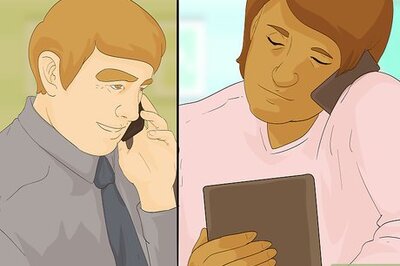


Comments
0 comment